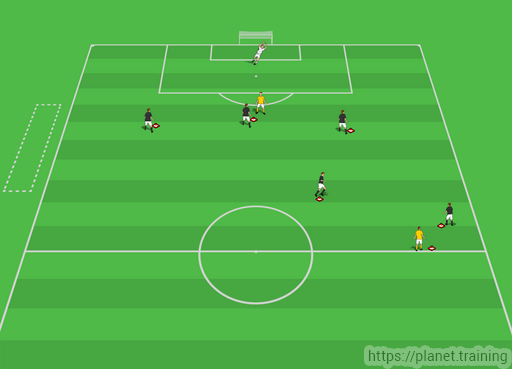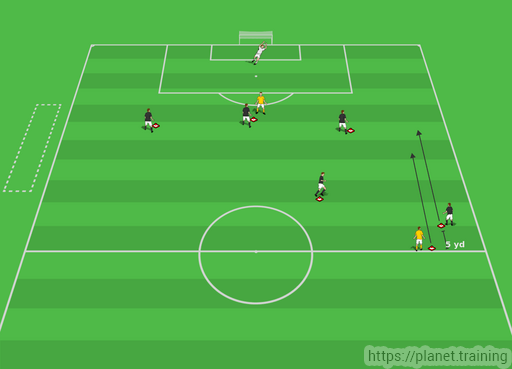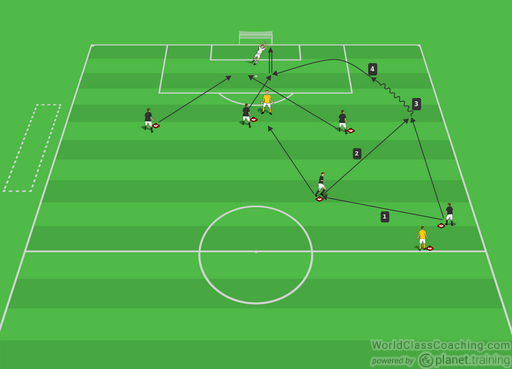By Anthony Hazelwood
The following activity activates the attacking players to develop a flank combination with the objective in creating a crossing and finishing opportunity. This activity is a linear and non-linear type of exercise with the soccer specific fitness target being the player and group athletic development. The metabolic training adaptations are meant for speed production. The time of action for each repetition should be around 8 to 10 seconds’ max and the resting period for each athlete after each action should be around 40 to 60 seconds. The reason for the resting period being larger in an amount in comparison to the intensive action is to promote complete recovery before commencing the following action. Therefore, not fatiguing the athlete and having them perform their action at a pristine level.
When preparing the activity, if needed, concentration and difficulty levels may be increased by having players execute something extra unique by setting more restrictions. Every activity may be modified, and it is up to the coach to be creative. However, it is important to respect the parameters of the exercise time, the rest, the types of actions used and the weekly periodization of the activity.
Additionally, it is beneficial to train a soccer team and its players with all the elements of the game being present in the session. By doing so, it will promote soccer specific adaptations to the player’s body, mind, and emotional triad. Ultimately, these adjustments will enhance their real-time game performances on a physical, emotional, conscious, and subconscious mental level.
Area Size: Half Field.
Total Activity Time: 12 Minutes.
Sets: 1.
Action Time: 6 – 10 seconds.
Recovery Interval Time between Action Time: 40 - 60 seconds (also depends on the number of players.)
Action Repetition: 9 – 12 reps.
Intensity: High.
Objectives:
• Tactical: Group Crossing/Finishing and Defending to goal.
• Fitness: Speed Production and Reaction.
• Technique: Proper fitness and off/on the ball execution/techniques.
• Mental-Emotional: Players fully engaged and concentration is high.
• Concentration Level: High.
Setup:

• 5 Attacking players are set up on the field as shown in the diagram above.
• Initially, there is two yellow defending players position as shown in the diagram.
• One yellow defender has the objective in defending in numerical inferiority when the ball is crossed.
• The other yellow defender is involved in a “cat and mouse” chase to stop the cross from happening.
• The play starts with the coach’s whistle or with the player starting at will.
• The flank player will pass to a teammate, and then perform a linear sprint to receive the pass again (wall pass). This will activate the defending player as well.

• Once the pass and go is complete, the player will receive the ball and perform the crossing and finishing portion.
• The chasing yellow defending player has the objective in trying to stop the cross from happening.
• The chasing defenders starting position is about 2 yds. lower than the attacking player. This makes it harder to stop the attacking player from performing a crossing action with the ball.
• Once the cross is performed, three attacking players run towards the box and attempt to score vs. one defender and the opposing GK.

Coaching Points:
• Mobility and creativity are important to unbalance defenders.
• Correct timing of crosses and runs into the box are essential.
• Players should read the situation and make correct runs to meet the ball at well-timed moments.
• Defending players need to BE extra intuitive and intensive in order to figure out ways to stop the team from crossing and scoring.
By Anthony Hazelwood
Current Seattle Sounders Academy Performance Coach with previous European academy coaching experience as an assistant fitness and strength/conditioning soccer coach with Levante U.D. (2013-2014) and Getafe SAD CF (2015-2016) in Valencia and Madrid, Spain respectively. A USSF “A” licensed coach with a BSc in Physical Education and an MSc in Sports Training and Nutrition.


